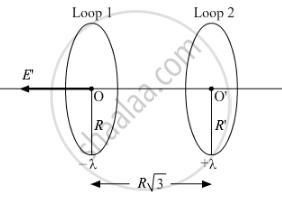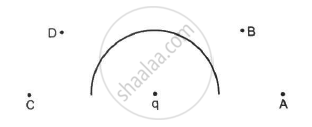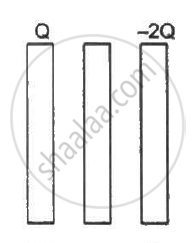Advertisements
Advertisements
प्रश्न
Two identical circular loops 1 and 2 of radius R each have linear charge densities −λ and +λ C/m respectively. The loops are placed coaxially with their centres `Rsqrt3` distance apart. Find the magnitude and direction of the net electric field at the centre of loop 1.
उत्तर
Magnitude of electric field at any point on the axis of a uniformly charged loop is given by,
`E=λ/(2∈_0) (rR)/(r^2+R^2)^(3/2) .....(i)`
where
R = Radius of the loop
r = Position of the point from the centre of the loop
λ = Linear charge density of the loop

Electric field at the centre of loop 1 due to charge present on it is zero. [ From (i), when r = 0 ]
`| vecE_1 | = 0 (As Z = 0)`
Electric field at a point outside the loop 2 on the axis passing normally is
`|vecE_2| = [lambdaR]/(2ε_0) . [Z]/[R^2 + Z^2]^(3/2)`
Since, Z = `Rsqrt3`
= `[lambdaR]/(2ε_0) . [Rsqrt3]/[(R^2 + 3R^2)^(3/2)]`
= `[lambdasqrt3]/[16ε_0R]` twowards right (As λ is positive)
So, net electric field at the centre of loop 1
`vecE = vecE_1 + vecE_2`
= 0 + `[lambdasqrt3]/[16ε_0R] = [lambdasqrt3]/[16ε_0R]`
This is the net electric field at the centre of loop 1 due to the charge on both the loops. The direction of this net field is from loop 2 to loop 1 as shown in the above figure.
APPEARS IN
संबंधित प्रश्न
(i) If two similar large plates, each of area A having surface charge densities +σ and –σ are separated by a distance d in air, find the expressions for
(a) field at points between the two plates and on outer side of the plates. Specify the direction of the field in each case.
(b) the potential difference between the plates.
(c) the capacitance of the capacitor so formed.
(ii) Two metallic spheres of Radii R and 2R are charged so that both of these have same surface charge density σ. If they are connected to each other with a conducting wire, inn which direction will the charge flow and why?
In the following figure shows a charge q placed at the centre of a hemisphere. A second charge Q is placed at one of the positions A, B, C and D. In which position(s) of this second charge, the flux of the electric field through the hemisphere remains unchanged?
(a) A
(b) B
(c) C
(d) D

The radius of a gold nucleus (Z = 79) is about 7.0 × 10-10 m. Assume that the positive charge is distributed uniformly throughout the nuclear volume. Find the strength of the electric field at (a) the surface of the nucleus and (b) at the middle point of a radius. Remembering that gold is a conductor, is it justified to assume that the positive charge is uniformly distributed over the entire volume of the nucleus and does not come to the outer surface?
Consider the following very rough model of a beryllium atom. The nucleus has four protons and four neutrons confined to a small volume of radius 10−15 m. The two 1 selectrons make a spherical charge cloud at an average distance of 1⋅3 ×10−11 m from the nucleus, whereas the two 2 s electrons make another spherical cloud at an average distance of 5⋅2 × 10−11 m from the nucleus. Find three electric fields at (a) a point just inside the 1 s cloud and (b) a point just inside the 2 s cloud.
Find the magnitude of the electric field at a point 4 cm away from a line charge of density 2 × 10-6 Cm-1.
Three identical metal plates with large surface areas are kept parallel to each other as shown in the following figure. The leftmost plate is given a charge Q, the rightmost a charge −2Q and the middle one is kept neutral. Find the charge appearing on the outer surface of the rightmost plate.

A block of mass containing a net positive charge q is placed on a smooth horizontal table which terminates in a vertical wall as shown in the figure. The distance of the block from the wall is d. A horizontal electric field E towards the right is switched on. Assuming elastic collisions (if any), find the time period of the resulting oscillatory motion. Is it a simple harmonic motion?

A uniform field of 2.0 NC−1 exists in space in the x-direction. (a) Taking the potential at the origin to be zero, write an expression for the potential at a general point (x, y, z). (b) At which point, the potential is 25 V? (c) If the potential at the origin is taken to be 100 V, what will be the expression for the potential at a general point? (d) What will be the potential at the origin if the potential at infinity is taken to be zero? Is it practical to choose the potential at infinity to be zero?
A charge Q is applied to a conducting sphere of radius R. At the sphere's centre, the electric potential and electric field are respectively
